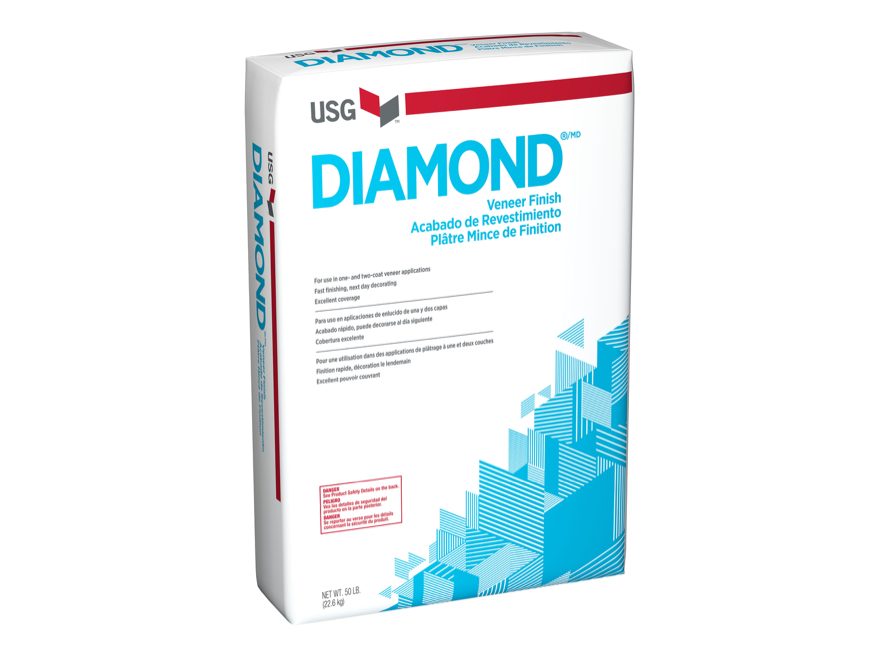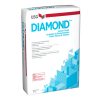Sign In
You're All Set
Welcome back! You are now signed in.
You have been logged out
You have been logged out due to inactivity
Forgot Password
Please enter the email address you used to create the account. We'll send you a link that lets you create a new password.
You're All Set
Please check your email. Click the link in the email to create a new password.
Reset Password
You're All Set
Success! Your password has been updated.
Change Password
You're All Set
Success! Your password has been updated.


Diamond® Veneer Finish
Economical way to give walls and ceilings a strong, hard surface that resists surface cracking.
Key Documents & Design Files
Overview
Overview
Main Features
Diamond® Veneer Finish is formulated for hand application over Imperial® Gypsum Base or as a finish of a two-coat system over a sanded gypsum basecoat, Imperial® Basecoat Plaster or Diamond® Veneer Basecoat Plaster.- Harder than regular gauging and lime putty finish
- Finish coat for one- and two-coat veneer plaster systems
- Fast-applying — permits next day decorating
- Excellent coverage — as much as 6,000 sq. ft. per ton
- Choice of smooth-trowel and textured finishes
- Job-sanded for use as radiant heat plaster
Applications
- Administrative Offices
- Auditoriums and Gymnasiums
- Bars Restaurants and Dining Areas
- Cafeterias
- Classrooms
- Convention and Meeting Rooms
- Corridors and Hallways
- Department Stores and Boutiques
- Dormitories
- Executive Areas, Conference Areas and Board Rooms
- Exterior Soffits and Indoor Parking Garage
- Galleries and Exhibit Spaces
- Garages
- Grocery Stores
- Guest Rooms and Suites
- Health and Fitness
- Kitchens and Food Prep Areas
- Laboratories, Operating Rooms and Imaging Rooms
- Lobbies and Reception Areas
- Locker Rooms, Shower Areas and Pools
- Mall Interior Spaces
- Mechanical Rooms
- Media Centers, Music Rooms and Libraries
- Multi-Family Residential and Condos
- Nurseries and Birthing Rooms
- Open Plan Offices
- Patient Rooms
- Restrooms, Utility Rooms and Loading Docks
- Single-Family Residential
- Stairways and Elevator Shafts
- Theatres
- Traditional Offices
- Warehouses
Installation
Installation Guide PDF 80.2 KB
Documents & Files
Data Sheets & Specifications
| Data/Submittal Sheet (English) |
Catalogs & Brochures
| Brochure (English) | PDF 2.4 MB |
Project Profiles
| Project Profiles (English) | PDF 1.3 MB |
Installation & Technical Manuals
| Technical Guide (English) | |
| Installation Guide (English) | PDF 80.2 KB |
SDS, Certifications & Reports
| SDS (English) |
| SDS (Spanish) |
Sustainability
| Greenguard Certificate (English) |
Ask a question
Our customer support team will get back to you as soon as possible.
Question Guidlines
- Questions should relate to this product specifically.
- For help with pricing, availability, or delivery, please call 800.874.4968 (Monday–Friday, 7am–6pm Central)
- All questions and answers follow USG’s Terms & Conditions.
- Your question and USG’s answer may be posted to this page in the future, but none of your personal info will be included.
q & a
-
What is the recommended stud spacing for installing conventional plaster?
Do not exceed 16 inches on center.
-
Can conventional 3-coat plaster be used with drywall grid?
Yes. If the main tees, cross tees and hanger wires are properly sized and spaced to carry the plaster load and only Red Top®; Structo-base® gypsum basecoat plaster is used for the scratch and brown coats.
-
Can USG Veneer Plaster be applied directly over CMU?
The CMU must cure for at least 45 to 60 days prior to the plaster application. Refer to USG system folder SA920 for specific application directions.
-
When can veneer plaster be painted?
Veneer plaster can be painted when it is completely dry. The best way to determine if the plaster is dry is by taping a piece of 12" by 12" plastic to the surface. If any moisture remains on the plastic after 24 hours then the plaster is not completely dry.
-
How should the Color Trend colorant and water be mixed?
Mix Color Trend and water together in a bucket using a heavy-duty 450-RPM drill with a drywall blade-type joint compound paddle. Turn the drill on and off several times to evenly disperse the colorant through the water and to prevent splashing.
-
When using Diamond® Veneer Finish, does it matter if some of the colorant is spilled or splashed out during mixing?
Yes. Any loss of the colorant causes color variation in the finished material.
-
What are the only base coat plasters that can be used as the scratch and brown coat for a conventional 3-coat application over wide-flange (1 inch or greater) framing?
USG has three products that can be used: Red Top® Gypsum Plaster, Red Top® Wood-Fiber Gypsum and USG® Structo-Base® Gypsum Plaster.
-
Can plaster be used for grouting doorframes?
Yes, but only on open throat doorframes, per door manufactures requirements. Red Top® Gypsum Plaster mixed with sand is most commonly used for full grouts. (Recommendation: 1-part Red Top Gypsum/ 2-parts sand per bag)
See the Gypsum Construction Handbook for full details.
-
When can a conventional plaster system be painted?
A conventional plaster system can be painted after it is completely dry.
-
What is the shelf life of plaster?
Plaster can be stored 3-6 months if it is stored in a cool, dry place, protected from extreme heat and cold, direct sunlight and at a temperature above 45°F (7°C).
-
What is the best way of repairing an old wood lath plaster application?
Remove the old plaster down to the wood lath, staple metal over the existing lath and apply Red Top® sanded conventional basecoat over the metal lath. Any USG finish plaster can be applied over the basecoat plaster for a final coat.
-
Why must a color be picked that is darker than the actual color wanted?
A color darker than the desired result must be selected to compensate for the color change that occurs when the plaster is applied and dries.
-
What paints are recommended for decorating veneer plaster?
Consult paint manufacture for proper primer selection for both lime-containing finish plasters, such as Diamond® Veneer Finish; or non-lime-containing finish plasters such as Imperial® Veneer Finish. See literature piece PM15 for Preparation for Painting details.
-
Can Veneer Plaster be applied to sun-faded USG Imperial® Brand Gypsum Base?
No. An alum spray must be applied prior to application.
-
What are the deflection design criteria for installing plaster systems?
When installing a veneer plaster system it should be designed at deflection L/240 and L/360 for a Conventional Plaster system.
-
What is the difference between USG Imperial® Veneer Finish Plaster and USG Diamond® Veneer Finish Plaster?
USG Imperial® Veneer Finish Plaster is stronger and more abrasion resistant.
USG Diamond® Veneer Finish Plaster is designed for ease of use and slightly improved abrasion resistance when compared to gypsum panels.
-
What is the recommended spacing of control joints for a plaster system?
Control joints are not to exceed 30 feet for walls and ceilings. The spacing for a ceiling with perimeter relief is not to exceed 50 feet.
-
Can USG Red Top® Brand Finish Plaster be applied over Veneer Basecoats?
Yes. Mill-mixed USG Red Top® Brand Finish Plaster or other job-site lime/gauging plasters can be applied over Veneer Basecoats.
-
What if the sealer starts to drip?
Immediately wipe off any drips using a soft, absorbent lint-free cloth.
-
Have a question?
Ask USGLet us do the research. We'll get back to you as quickly as we can.
-
Need help right away?
Call our Technical Support team at 800-874-4968 (Monday-Friday, 7:30 am - 4 pm Central).



